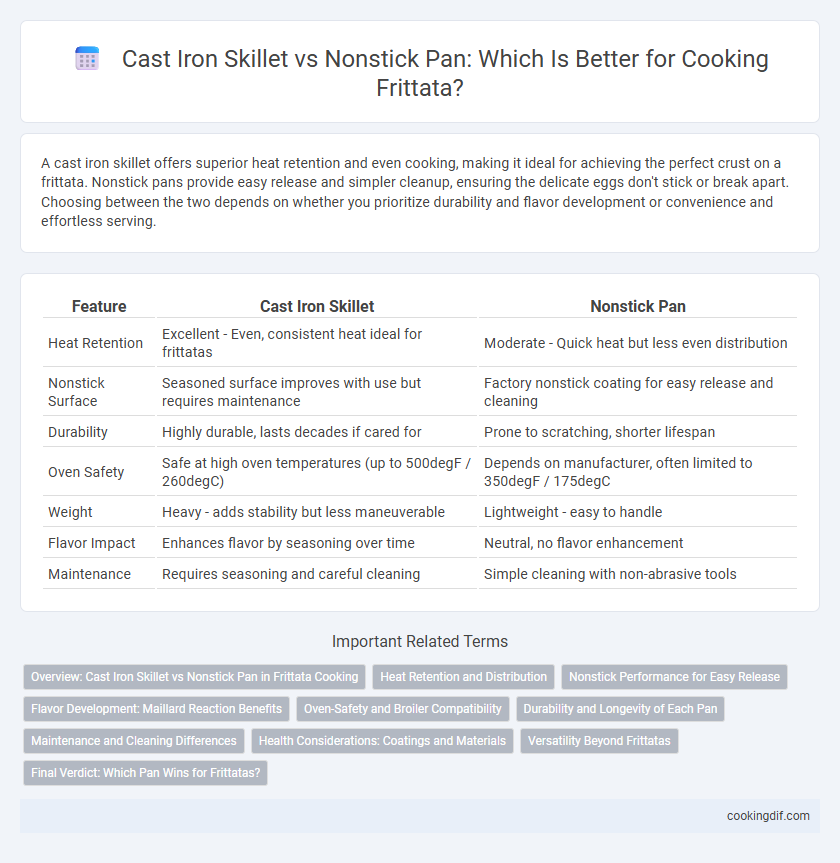A cast iron skillet offers superior heat retention and even cooking, making it ideal for achieving the perfect crust on a frittata. Nonstick pans provide easy release and simpler cleanup, ensuring the delicate eggs don't stick or break apart. Choosing between the two depends on whether you prioritize durability and flavor development or convenience and effortless serving.
Table of Comparison
| Feature | Cast Iron Skillet | Nonstick Pan |
|---|---|---|
| Heat Retention | Excellent - Even, consistent heat ideal for frittatas | Moderate - Quick heat but less even distribution |
| Nonstick Surface | Seasoned surface improves with use but requires maintenance | Factory nonstick coating for easy release and cleaning |
| Durability | Highly durable, lasts decades if cared for | Prone to scratching, shorter lifespan |
| Oven Safety | Safe at high oven temperatures (up to 500degF / 260degC) | Depends on manufacturer, often limited to 350degF / 175degC |
| Weight | Heavy - adds stability but less maneuverable | Lightweight - easy to handle |
| Flavor Impact | Enhances flavor by seasoning over time | Neutral, no flavor enhancement |
| Maintenance | Requires seasoning and careful cleaning | Simple cleaning with non-abrasive tools |
Overview: Cast Iron Skillet vs Nonstick Pan in Frittata Cooking
A cast iron skillet offers superior heat retention and even cooking, essential for achieving the perfect frittata crust and consistent internal texture. Nonstick pans provide easy release and quick cleanup, making them ideal for delicate egg dishes and less oil usage. Choosing between cast iron and nonstick depends on balancing durability and cooking performance with convenience and maintenance.
Heat Retention and Distribution
Cast iron skillets excel in heat retention and distribution, maintaining consistent high temperatures essential for an evenly cooked and crispy frittata crust. Nonstick pans heat up quickly but often develop hot spots and cool down faster, risking uneven cooking and a less stable texture. Using a well-seasoned cast iron skillet ensures superior thermal performance, resulting in a perfectly browned, tender interior and crisp exterior of the frittata.
Nonstick Performance for Easy Release
Nonstick pans provide superior performance for easy release when cooking frittatas, minimizing the risk of sticking and ensuring flawless slices. Their smooth surface allows even heat distribution, preventing burn spots and promoting uniform cooking. Compared to cast iron skillets, nonstick pans require less oil and offer effortless cleanup, making them the ideal choice for delicate egg dishes.
Flavor Development: Maillard Reaction Benefits
Cast iron skillets excel in flavor development for frittatas due to their superior heat retention and even cooking, which promotes the Maillard reaction, resulting in a rich, caramelized crust. Nonstick pans, while easier to clean, often lack the high-heat capacity needed for optimal browning, leading to less complex flavors. The durable surface of cast iron enables consistent searing, enhancing umami and depth in the final dish.
Oven-Safety and Broiler Compatibility
A cast iron skillet offers superior oven-safety and broiler compatibility, enduring high temperatures up to 500degF or more without damage, making it ideal for frittatas requiring oven finishing or broiling. Nonstick pans typically have temperature limits around 400degF and are generally not recommended for broiler use due to potential coating degradation and toxin release. Choosing a cast iron skillet ensures durability and safe, even cooking under intense oven or broiler heat.
Durability and Longevity of Each Pan
Cast iron skillets boast exceptional durability, often lasting a lifetime when properly seasoned and maintained, making them ideal for frequent frittata cooking. Nonstick pans offer convenience but typically have a shorter lifespan, with coatings degrading over 3 to 5 years, which can affect cooking performance. The robust construction of cast iron resists warping and scratches, providing superior longevity compared to nonstick alternatives.
Maintenance and Cleaning Differences
Cast iron skillets require seasoning to maintain their nonstick surface and prevent rust, involving regular oiling after each use and careful hand-washing without soap. Nonstick pans offer easier cleaning with gentle dish soap and a soft sponge but can deteriorate quickly if scratched or exposed to high heat. Proper maintenance of cast iron extends its lifespan and enhances flavor, while nonstick pans prioritize convenience but may need more frequent replacement.
Health Considerations: Coatings and Materials
Cast iron skillets, made from natural iron, provide a chemical-free cooking surface that can enhance iron intake, beneficial for individuals with iron deficiency. Nonstick pans often contain PTFE coatings, which may release harmful fumes when overheated, posing potential health risks. Choosing a cast iron skillet avoids exposure to synthetic chemicals, promoting a safer cooking environment for preparing frittatas.
Versatility Beyond Frittatas
A cast iron skillet offers superior heat retention and durability, making it ideal for high-temperature cooking methods beyond frittatas, such as searing, roasting, and baking. Nonstick pans provide easy release and quick cleanup, but they often lack the versatility needed for developing complex flavors in dishes like sauteed vegetables or pan-roasted meats. Cast iron's ability to go from stovetop to oven expands culinary possibilities, enhancing its value beyond just cooking frittatas.
Final Verdict: Which Pan Wins for Frittatas?
A cast iron skillet outperforms nonstick pans for frittatas by providing superior heat retention and even cooking, resulting in a perfectly browned crust and consistent texture. Its durability and ability to withstand high oven temperatures enhance the overall cooking process, especially for finishing frittatas under a broiler. While nonstick pans offer easy release and cleanup, the cast iron skillet's versatility and flavor development make it the definitive choice for crafting authentic, restaurant-quality frittatas.
Cast Iron Skillet vs Nonstick Pan for cooking vessel Infographic

 cookingdif.com
cookingdif.com